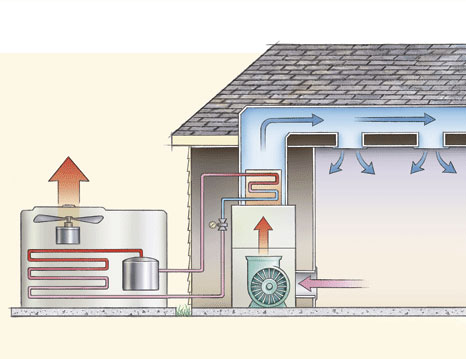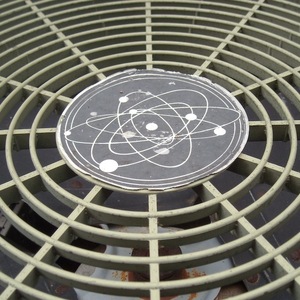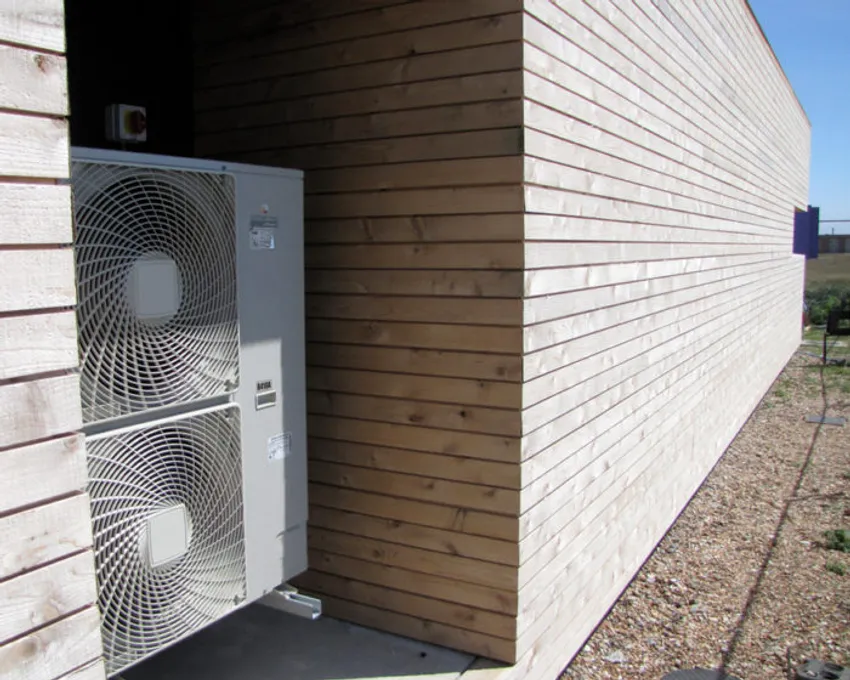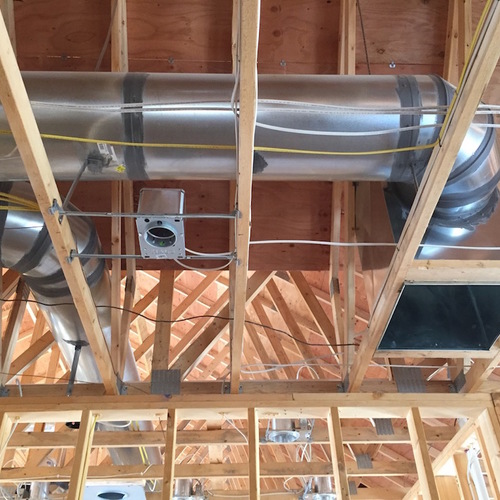
One of the most frustrating parts of my job as a Home Energy Rating (HERS) provider is dealing with the size of air conditioners installed in Energy Star homes. My frustration has spilled over in the Energy Vanguard blog several times, and the topic in all its manifestations (HVAC sizing, Manual J load calculations, the HVAC industry…) has been one of my favorites to write about. I’ve got an idea of how to make things better now, though. Keep reading.
Today it happened again. I was checking HERS rating files, and, as I usually do, I applied my AC sizing rule of thumb to see if the HVAC contractors treated the homes as a true high performance homes. Turns out they didn’t. For the three homes in question, the air conditioning capacity was one ton for each 529 square feet, 544 sf, and 781 sf. Those numbers are not good. The first two, actually, are terrible.
In case you’re new to this subject, air conditioners should be sized to meet the cooling load of the house, and bigger is NOT better. If the AC is too big, it doesn’t run long enough to dehumidify well, and the constant on-and-off cycles will shorten the life of the equipment. A Manual J load calculation is how you find out what size air conditioner the house needs.
So, here’s my idea, and I’m starting a campaign for it. HVAC contractors like rules of thumb, so let’s take that idea and adapt it. If you’re a builder, home buyer, HVAC contractor, or real estate agent, here’s a way that you can do a quick analysis to see if the air conditioner is oversized: Find the conditioned floor area. Find the air conditioner’s capacity in tons. Divide the former by the latter. What you get is the number of square feet of conditioned floor area per ton of AC capacity.
I told you above that 529, 544, and 781 aren’t good, so what is a good number? As a rough guide, you can use the following:
High Performance Home = 1000 sf/ton or more
We’ve done a lot of load calculations here at Energy Vanguard, and I don’t think we’ve had a single new home come in lower than 1000 sf/ton. I built a house here in Georgia that came in at about 2000 square feet per ton, and we recently worked on another one that was higher than that. This number, 1000 sf/ton, should be your baseline. Nothing lower than that should be acceptable.
Now before you get all in a huff and accuse me of being a hypocrite for promoting a rule of thumb, let me explain that I’m not saying the rule of thumb above is a subsitute for Manual J. Yeah, we could come up with a number for each location (e.g., 1100 sf/ton in Dallas, 24,000 sf/ton in Seattle, 0.00000000000000000000000001 sf/ton in Hell…), but you still have to do a room-by-room Manual J load calculation to select equipment and design ducts properly.
Where this rule of thumb could really shine is for these three things:
1. Helping home builders know if their HVAC contractor is in the ballpark of proper HVAC sizing
If a home builder is taking care of the building envelope, getting the ducts sealed, and doing all the things you have to do to build a high performance home, they can use this as a guide in negotiating with their HVAC contractor. When the HVAC contractor tells the builder what they want to install, the builder can quickly see how it compares to our benchmark. (Of course, if the builder uses a third party for HVAC design, then they don’t need to use this benchmark because they’ll have a better number.)
2. Helping home buyers know if they might be buying a home with an oversized air conditioner
Home buyers can get their calculators out and do this simple calculation. If they’re buying what’s supposed to be an energy efficient home and the number is far below 1000 sf/ton, then either the house isn’t really so efficient or the system is oversized. In either case, they can steer clear of it and look for a real high performance home.
3. Simplifying programs like ENERGY STAR new homes
The ENERGY STAR new homes program has been great for moving the whole new homes market toward greater energy efficiency. If you’ve taken a look at the new Version 3 guidelines, however, you probably felt a bit woozy afterward. They’ve made the program too complex, especially for HVAC. A rule of thumb like this could reduce everyones’ headaches.
Size Matters
You know what’s really good about this new rule of thumb? It satisfies our natural urge to believe that bigger is better! No one wants to say to their neighbor:
“Hey, Bob, I bet mine’s smaller than yours.”
But they will say:
“Dude, you got only 529 square feet per ton. I’ve got 1500! BwaaHaaaHaaaa”
Because psychologically, size matters and bigger is better. So let’s give ’em a way to claim the numerical high ground with this new benchmark. (This use of the reciprocal function is a form of mathematical aikido.)
Now we just need a catchy name, a jingle, and some good PR for our new benchmark. Got any ideas?
Allison Bailes of Decatur, Georgia, is a RESNET-accredited energy consultant, trainer, and the author of the Energy Vanguard blog.
Weekly Newsletter
Get building science and energy efficiency advice, plus special offers, in your inbox.















14 Comments
Good work
Allison, I'm glad to see some of those really high sqft per ton numbers. I wonder if the higher than 2000 one was an ICF home. I know an ICF home in GA that was 2600/ton, and with a higher SEER unit, it was going to be over 3000. I don't, however, like the idea of the 1000 sqft per ton rule of thumb as an indicator of a tight, energy efficient home because, as you mentioned, different climates, conditions, and systems play with that number. I guess it does help you know if your ME is way off.
>2000 sf/ton without ICFs
Bradley, no, the house is built (~2000 sf/ton) was framed with structural insulated panels (above-grade walls and roof), and the other one was stick-built. Now, the stick-built house wasn't your typical framed house, though. They used 2x8 walls with cavities filled with spray foam and foam board on the outside. The basement slab had insulation (perimeter and beneath), and the foundation walls had spray foam, too. The roof had lots of spray foam. This builder really likes to max out the envelope because he's building for family and wants everything to be perfect.
I proposed the 1000 sf/ton benchmark mainly as a rough guide to help builders and home buyers with sizing. I'd love to see ENERGY STAR go this route, but I don't think they will anytime soon. Their investment in the complexity of V3 is pretty high at this point.
Cooling/Heating Load Mystery
Your idea would be helpful for the new or prospective homeowner to help them assess whether the AC was over-sized for their house.
But to be honest, it's a mystery to me why a builder of a "high-performance" home wouldn't go through the process of figuring out the cooling load as part of their design process? Yes the builder of a "high performance" home probably knows that he is designing/building a more energy efficient home, but you can't examine the variety of options nor choose the best or most cost effective one if the designer doesn't model the cooling/heating loads. If it's common practice for designers of "high performance" homes to leave the energy modeling to the ME or HVAC contractor than I'd suggest that most designer's are "winging it".
I couldn't help noticing the Google ad for HVACComputer (hvaccomputer.com) that appeared as I wrote this. I used HVACComputer to figure out the heating/cooling load on my house. A home designer/builder would certainly have the necessary knowledge to use this software, so why do so many designer/builders not bother with this learning and design opportunity? I anticipate that some of the CAD software will integrate energy modeling soon enough. The sooner the better, for everyone.
Cheers,
Andrew
To the tune of Tenessee Williams "Sixteen Tons"
You cool sixteen tons and what do you get?
Your house gets clammy and your stuff gets wet.
A ton is right for a thousand square feet,
So keep it simple and the system's sweet.
Bigger ain't better (for cooling I mean)
A ton for a grand is the right machine
The latent heat is the bad boy here,
So size that unit and you've earned a beer.
You see me comin' better size that right,
Or else you're goin' to face a fight.
Raters ain't puttin' up with that stuff,
You got to learn that enough is enough.
Which Tennessee?
I think it might have been Tennessee Ernie Ford who wrote that song. Tennessee Williams wrote "A Streetcar Named Desire" among other high-sexual tension plays. Nice lyrics in any case, Ed.
Thanks, Carl?
Thanks Carl . . . Nothing like making an egregious misattribution on line; now it will haunt me to my dying day.
Oh well . . . it's like North and South Carolina: we northerners can't keep them straight. I'll have to shout up to my wife and teller her what happened: "Hey!! STELLA!!!!"
Getting a 1 ton heat pump for 1000 sq ft home
I had asked my supplier to install a 1.5 ton heat pump, but when he checked my house he indicated that 1 ton would suffice. Heating will work down to -13 F. ROI of around 10%, and reduces CO2 footprint. Pretty good deal all round.
Another data point
In our new and superinsulated house, we have a two-ton (ground source) heat pump. If you count the utility space downstairs, stairwell, and closets, the house has perhaps 3700 square feet of space. Including the utility space area is sort of cheating, as its walls are nearly all underground, with R20 of insulation in those walls and under the slab. But that's just another reason for avoiding rules of thumb when sizing A/C. Not all square feet are the same, energy-wise.
That two ton heat pump still is considerably oversized for A/C. The energy model said a one-ton unit would be sufficient. The unit size was determined by heating needs. It got used fairly little this summer, and mainly for humidity reduction. A handful of hours, even in the hottest weather, was all it took to keep the house comfortable.
HVAC Sizing Software
A while back I bought a “little” HVAC sizing program called EMS (Energy Marketing Service) for $180. I like the fact that it performs really close calcs to the HVAC contractors, once they do their calcs the right way. The beauty of it all is that they use a fancy and expensive program and I don’t. I like the fact I can check my findings with theirs and make sure the load calcs are close.
EMS is more simplistic and much less cumbersome than Elite’s or Wrightesoft’s; but if you are an Architect, a Designer or a Builder, I highly recommend you get one of these programs. I used it in dozens of homes and it’s helped me every single time to make the HVAC guys lower their equipment and bids. They even have free upgrades and it only takes minutes to learn. See http://www.johnrwhite.net for more info.
Climate adjustment
Why is it so hard to adjust for climate? Can' you just use heating degree days for the furnace?
Response to Robert Nemoyer
Robert,
I'm not sure what you mean by "adjust for climate." I'm also confused by your reference to sizing furnaces according to heating degree days -- after all, this is a blog about sizing air conditioners
When it comes to sizing heating and cooling equipment, there are many factors to consider: the climate, the orientation of each window, the window specs, the shading of each window, the R-values of the walls and ceiling, and the air leakage rate of the home -- among many other factors. You certainly can't use heating degree days alone to size a furnace. And you certainly can't use heating degree days to size an air conditioner.
Energy Calculations
I think that people are becoming more aware of how important load calculations are when replacing or installing new air conditioning equipment. The drawbacks from oversizing are numerous, we are used to a bigger is better philosophy and with HVAC it simply isn't the case.
Climate Change
I wonder if your rule-of-thumb is still valid in a more extreme climate environment. Here in the Dallas area, we just finished a week of 110F highs. If this is the new normal, as seems more and more to be the case, perhaps your issue warrants additional thought.
A friend living in a 4yr old 1200 sq ft home with a 3ton unit remained comfortable with the thermostat set to 78F, although the system was runniing almost constantly during the daytime. According to your rule-of-thumb, that home has a very oversized AC unit.
I’m having a similar home built nearby, and am opting for a 2.5 ton unit. Although my home will be slightly smaller and a bit better insulated than my neighbor, I feel uncomfortable selecting a 1.5 or even a 2.0 ton unit as your recommendation would suggest.
Here in northern Texass, it’s either very hot, or hardly worth turning on the AC at all. Unlike more temperate climates such as Southern California. (Although even such comfortable climates may be subject to change in the near future.) So to my way of thinking, your rule of thumb may require a few important caveats.
Thank you all for your thoughts and comments... I'm also wondering how climate change may effect this rule of thumb in years to come. Also, modern building techniques.
Log in or create an account to post a comment.
Sign up Log in